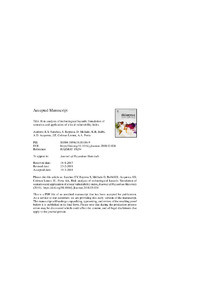Por favor, use este identificador para citar o enlazar este ítem:
https://repositorio.uca.edu.ar/handle/123456789/14740| Campo DC | Valor | Lengua/Idioma |
|---|---|---|
| dc.contributor.author | Sánchez, E. Y. | es |
| dc.contributor.author | Represa, S. | es |
| dc.contributor.author | Mellado, D. | es |
| dc.contributor.author | Balbi, K. B. | es |
| dc.contributor.author | Acquesta, Alejandro Dante | es |
| dc.contributor.author | Colman Lerner, J. E. | es |
| dc.contributor.author | Porta, A. A. | es |
| dc.date.accessioned | 2022-08-23T13:21:58Z | - |
| dc.date.available | 2022-08-23T13:21:58Z | - |
| dc.date.issued | 2018 | - |
| dc.identifier.citation | Sánchez, E. Y., et al. Risk analysis of technological hazards: Simulation of scenarios and application of a local vulnerability index [en línea]. Journal of Hazardous Materials. 2018, 352 doi: 10.1016/j.jhazmat.2018.03.034 Disponible en: https://repositorio.uca.edu.ar/handle/123456789/14740 | es |
| dc.identifier.issn | 0304-3894 | - |
| dc.identifier.uri | https://repositorio.uca.edu.ar/handle/123456789/14740 | - |
| dc.description.abstract | The potential impact of a technological accident can be assessed by risk estimation. Taking this into account, the latent or potential condition can be warned and mitigated. In this work we propose a methodology to estimate risk of technological hazards, focused on two components. The first one is the processing of meteorological databases to define the most probably and conservative scenario of study, and the second one, is the application of a local social vulnerability index to classify the population. In this case of study, the risk was estimated for a hypothetical release of liquefied ammonia in a meat-packing industry in the city of La Plata, Argentina. The method consists in integrating the simulated toxic threat zone with ALOHA software, and the layer of sociodemographic classification of the affected population. The results show the areas associated with higher risks of exposure to ammonia, which are worth being addressed for the prevention of disasters in the region. Advantageously, this systemic approach is methodologically flexible as it provides the possibility of being applied in various scenarios based on the available information of both, the exposed population and its meteorology. Furthermore, this methodology optimizes the processing of the input data and its calculation. | es |
| dc.format | application/pdf | es |
| dc.language.iso | eng | es |
| dc.publisher | Elsevier | es |
| dc.rights | Acceso abierto | * |
| dc.rights.uri | http://creativecommons.org/licenses/by-nc-nd/4.0/ | * |
| dc.source | Journal of Hazardous Materials. 2018, 352 | es |
| dc.subject | VULNERABILIDAD | es |
| dc.subject | TECNOLOGIA | es |
| dc.subject | RIESGO | es |
| dc.title | Risk analysis of technological hazards: Simulation of scenarios and application of a local vulnerability index | es |
| dc.type | Artículo | es |
| dc.identifier.doi | 10.1016/j.jhazmat.2018.03.034 | - |
| dc.identifier.pmid | 29597118 | - |
| uca.disciplina | INGENIERIA | es |
| uca.issnrd | 1 | es |
| uca.affiliation | Fil: Sanchez, E. Y. Universidad Nacional de La Plata. Centro de Investigaciones del Medio Ambiente; Argentina | es |
| uca.affiliation | Fil: Sanchez, E. Y. Consejo Nacional de Investigaciones Científicas y Técnicas; Argentina | es |
| uca.affiliation | Fil: Represa, S. Consejo Nacional de Investigaciones Científicas y Técnicas; Argentina | es |
| uca.affiliation | Fil: Represa, S. Universidad Nacional de La Plata. Centro de Investigaciones del Medio Ambiente; Argentina | es |
| uca.affiliation | Fil: Mellado, D. Consejo Nacional de Investigaciones Científicas y Técnicas; Argentina | es |
| uca.affiliation | Fil: Mellado, D. Universidad Nacional de La Plata. Centro de Investigaciones del Medio Ambiente; Argentina | es |
| uca.affiliation | Fil: Mellado, D. Instituto de Investigaciones Científicas y Técnicas para la Defensa; Argentina | es |
| uca.affiliation | Fil: Balbi, K. B. Universidad Nacional de La Plata. Centro de Investigaciones del Medio Ambiente; Argentina | es |
| uca.affiliation | Fil: Balbi, K. B. Consejo Nacional de Investigaciones Científicas y Técnicas; Argentina | es |
| uca.affiliation | Fil: Acquesta, Alejandro Dante. Instituto de Investigaciones Científicas y Técnicas para la Defensa; Argentina | es |
| uca.affiliation | Fil: Acquesta, Alejandro Dante. Pontificia Universidad Católica Argentina. Facultad de Ingeniería y Ciencias Agrarias; Argentina | es |
| uca.affiliation | Fil: Colman Lerner, J. E. Universidad Nacional de La Plata. Centro de Investigación y Desarrollo en Ciencias Aplicadas; Argentina | es |
| uca.affiliation | Fil: Colman Lerner, J. E. Consejo Nacional de Investigaciones Científicas y Técnicas; Argentina | es |
| uca.affiliation | Fil: Porta, A. A. Universidad Nacional de La Plata. Centro de Investigaciones del Medio Ambiente; Argentina | es |
| uca.affiliation | Fil: Porta, A. A. Consejo Nacional de Investigaciones Científicas y Técnicas; Argentina | es |
| uca.version | acceptedVersion | es |
| item.fulltext | With Fulltext | - |
| item.grantfulltext | open | - |
| item.languageiso639-1 | en | - |
| Aparece en las colecciones: | Libros/partes de libro | |
Ficheros en este ítem:
| Fichero | Descripción | Tamaño | Formato | |
|---|---|---|---|---|
| risk-analysis-technological.pdf | 546,37 kB | Adobe PDF |  Visualizar/Abrir |
Visualizaciones de página(s)
37
comprobado en 27-abr-2024
Descarga(s)
80
comprobado en 27-abr-2024
Google ScholarTM
Ver en Google Scholar
Altmetric
Altmetric
Este ítem está sujeto a una Licencia Creative Commons

